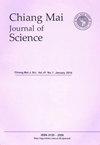Effects of pH on the Structure and Optical Property of Molybdenum Disulfide Nanocrystals Synthesized by Hydrothermal Method
IF 0.8
4区 综合性期刊
Q3 MULTIDISCIPLINARY SCIENCES
引用次数: 0
Abstract
Molybdenum disulphide (MoS2) is emerging as one of the most attractive two-dimensional (2D) materials amongst the transition metal dichalcogenides (TMDs) group. MoS2 exhibits a thickness-dependent band gap that changes from indirect band gap of ~1.3 eV for bulk MoS2 to direct band gap of ~1.9 eV in monolayer form. Such indirect-to-direct gap transition due to quantum confi nement results in giant enhancement in photoluminescence quantum yield. Recent study demonstrated that the co-existence of 2H- and 1T-MoS2 synthesized by hydrothermal method exhibited superior electronic conductivity to those with 2H semiconducting phase. Metallic 1T phase of MoS2 is attracting much attention due to its high electronic conductivity and potential applications in supercapacitors, thermoelectric energy harvesting, and memristors. In this paper, we investigated a hybrid structure between 2H and 1T of MoS2 by a hydrothermal process and investigated its optical property via photoluminescence spectra with changes in pH values. Our results indicated that photoluminescence occurred in the visible light region and the band gap was determined to be ~1.96–2.50 eV. In addition, pH of the precursor solution strongly affected the fi nal structure of MoS2 nanocrystals, which in turn, affected their photoluminescence property wherein pH = 4–5 was identifi ed as optimum for 2H–1T-MoS2 synthesis.pH对水热法制备二硫化钼纳米晶结构和光学性质的影响
二硫化钼(MoS2)是过渡金属二硫族(TMDs)中最具吸引力的二维(2D)材料之一。MoS2表现出厚度相关的带隙,从块状MoS2的约1.3 eV的间接带隙转变为单层形式的约1.9 eV的直接带隙。这种由量子确认引起的间接到直接的间隙跃迁导致了光致发光量子产率的巨大提高。最近的研究表明,水热法合成的2H-和1T-MoS2共存的材料比具有2H半导体相的材料具有更好的电子导电性。二硫化钼金属1T相由于其高电导率和在超级电容器、热电能量收集和忆阻器等方面的潜在应用而备受关注。本文通过水热法研究了二硫化钼的2H和1T杂化结构,并通过光致发光光谱研究了其随pH值变化的光学性质。结果表明,光致发光发生在可见光区,带隙为~1.96 ~ 2.50 eV。此外,前驱体溶液的pH强烈影响MoS2纳米晶体的最终结构,进而影响其光致发光性能,其中pH = 4-5被确定为2H-1T-MoS2合成的最佳条件。
本文章由计算机程序翻译,如有差异,请以英文原文为准。
求助全文
约1分钟内获得全文
求助全文
来源期刊

Chiang Mai Journal of Science
MULTIDISCIPLINARY SCIENCES-
CiteScore
1.00
自引率
25.00%
发文量
103
审稿时长
3 months
期刊介绍:
The Chiang Mai Journal of Science is an international English language peer-reviewed journal which is published in open access electronic format 6 times a year in January, March, May, July, September and November by the Faculty of Science, Chiang Mai University. Manuscripts in most areas of science are welcomed except in areas such as agriculture, engineering and medical science which are outside the scope of the Journal. Currently, we focus on manuscripts in biology, chemistry, physics, materials science and environmental science. Papers in mathematics statistics and computer science are also included but should be of an applied nature rather than purely theoretical. Manuscripts describing experiments on humans or animals are required to provide proof that all experiments have been carried out according to the ethical regulations of the respective institutional and/or governmental authorities and this should be clearly stated in the manuscript itself. The Editor reserves the right to reject manuscripts that fail to do so.
 求助内容:
求助内容: 应助结果提醒方式:
应助结果提醒方式:


